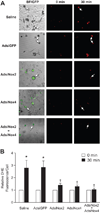Genetic silencing of Nox2 and Nox4 reveals differential roles of these NADPH oxidase homologues in the vasopressor and dipsogenic effects of brain angiotensin II
- PMID: 19805637
- PMCID: PMC2773438
- DOI: 10.1161/HYPERTENSIONAHA.109.140087
Genetic silencing of Nox2 and Nox4 reveals differential roles of these NADPH oxidase homologues in the vasopressor and dipsogenic effects of brain angiotensin II
Abstract
The renin-angiotensin system exerts a tremendous influence over fluid balance and arterial pressure. Angiotensin II (Ang-II), the effector peptide of the renin-angiotensin system, acts in the central nervous system to regulate neurohumoral outflow and thirst. Dysregulation of Ang-II signaling in the central nervous system is implicated in cardiovascular diseases; however, the mechanisms remain poorly understood. Recently we established that NADPH oxidase (Nox)-derived superoxide acting in the forebrain subfornical organ is critical in the physiological responses to central Ang-II. In addition, we have found that Nox2 and Nox4 are the most abundantly expressed Nox homologues within Ang-II-sensitive sites in the forebrain. To dissect out the functional importance and unique roles of these Nox enzymes in the pressor and dipsogenic effects of central Ang-II, we developed adenoviral vectors expressing small interfering RNA to selectively silence Nox2 or Nox4 expression in the subfornical organ. Our results demonstrate that both Nox2 and Nox4 are required for the full vasopressor effects of brain Ang-II but that only Nox2 is coupled to the Ang-II-induced water intake response. These studies establish the importance of both Nox2- and Nox4-containing NADPH oxidases in the actions of Ang-II in the central nervous system and are the first to reveal differential involvement of these Nox enzymes in the various physiological effects of central Ang-II.
Conflict of interest statement
None.
Figures





References
-
- Takei Y. Comparative physiology of body fluid regulation in vertebrates with special reference to thirst regulation. Jpn J Physiol. 2000;50:171–186. - PubMed
-
- Salzet M, Deloffre L, Breton C, Vieau D, Schoofs L. The angiotensin system elements in invertebrates. Brain Res Brain Res Rev. 2001;36:35–45. - PubMed
-
- Osborn JW, Fink GD, Sved AF, Toney GM, Raizada MK. Circulating angiotensin II and dietary salt: Converging signals for neurogenic hypertension. Curr Hypertens Rep. 2007;9:228–235. - PubMed
Publication types
MeSH terms
Substances
Grants and funding
LinkOut - more resources
Full Text Sources
Miscellaneous

